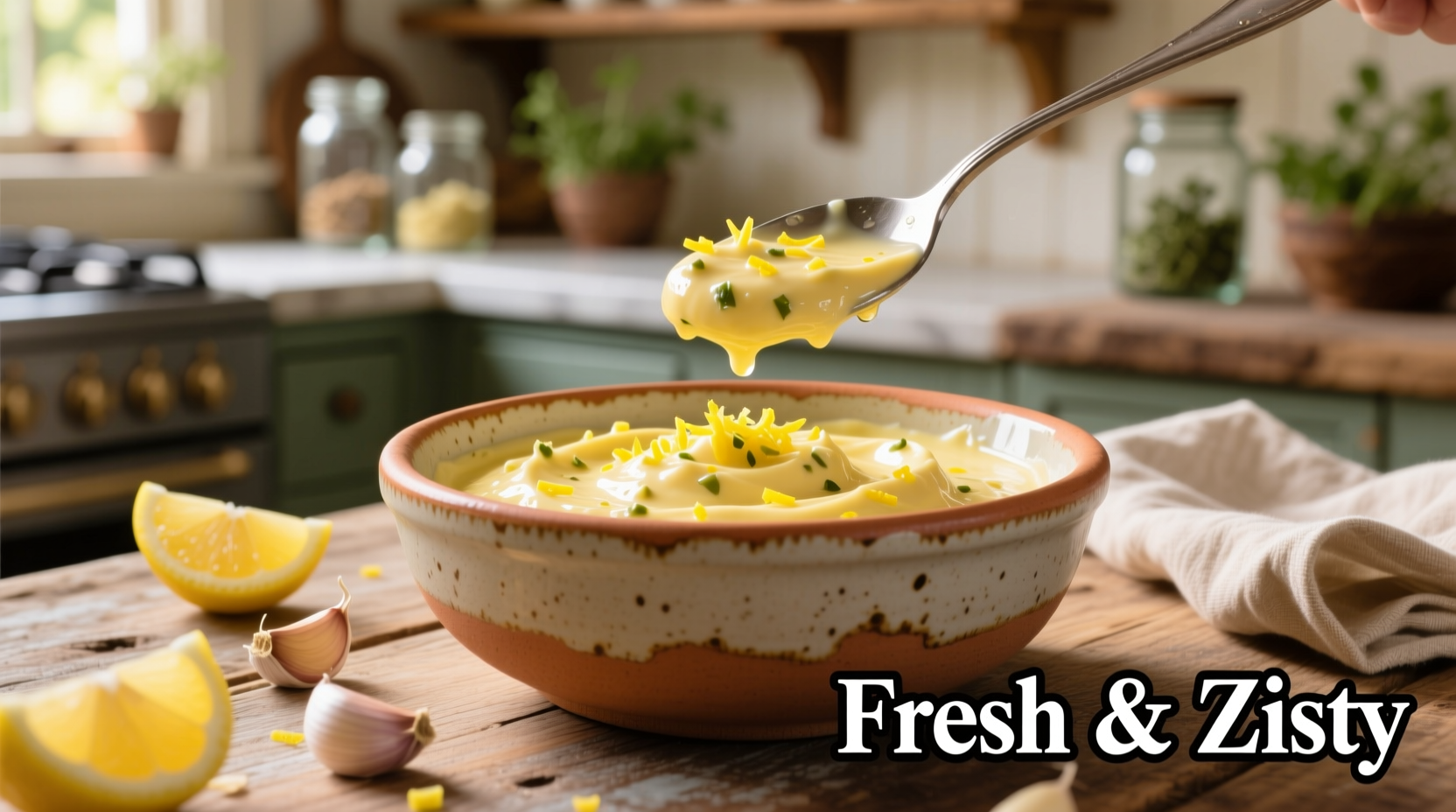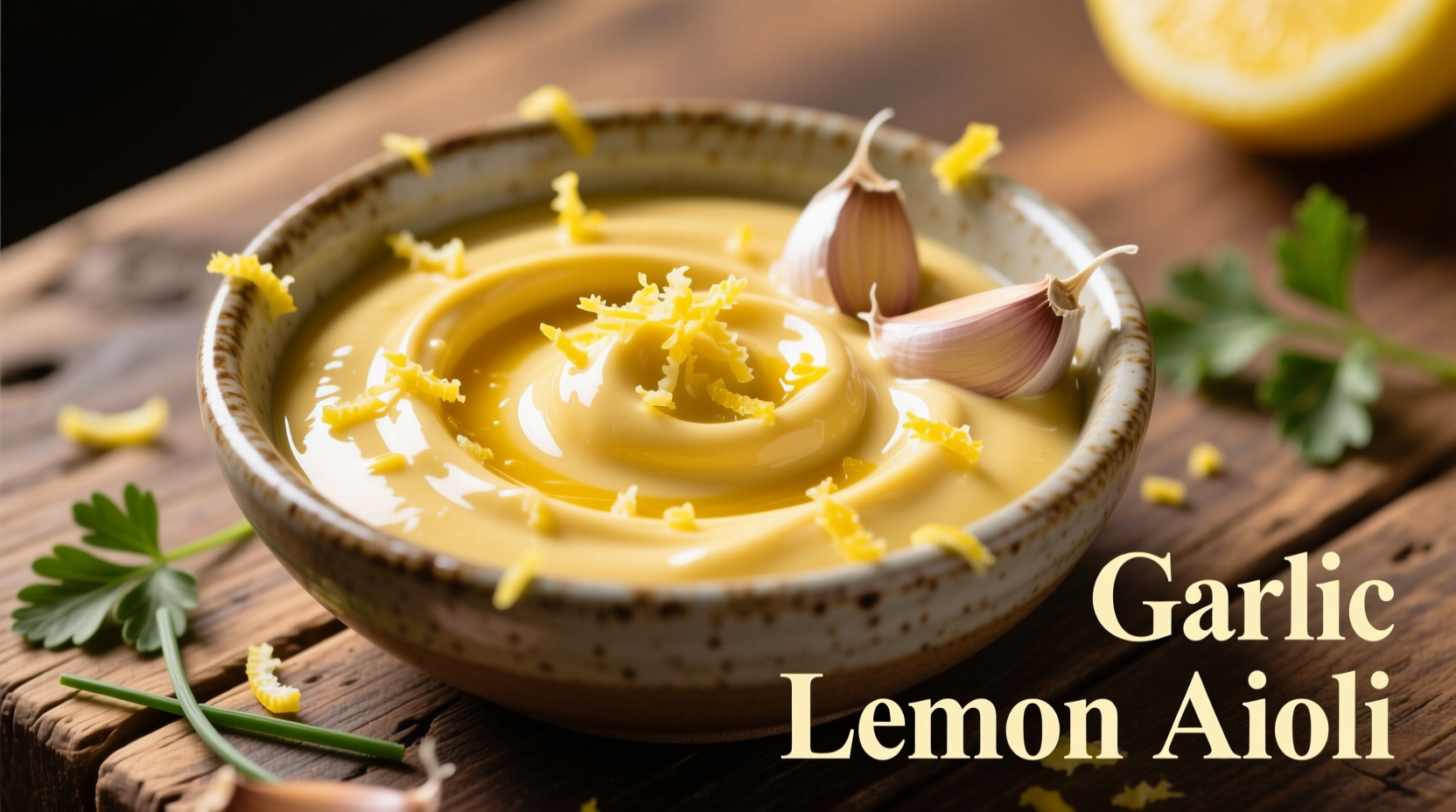The Essential Guide to Perfect Garlic Lemon Aioli Every Time
Garlic lemon aioli is more than just a sauce—it's a flavor powerhouse that elevates sandwiches, seafood, vegetables, and more. This creamy emulsion combines the pungent depth of garlic with the bright acidity of lemon, creating a balanced condiment that's both sophisticated and approachable. Unlike traditional mayonnaise-based sauces, authentic aioli relies on the emulsifying properties of garlic and oil, though modern variations often include egg yolks for stability.
Why Garlic Lemon Aioli Deserves a Place in Your Culinary Repertoire
Professional chefs consistently reach for garlic lemon aioli because of its remarkable versatility and ability to enhance dishes without overpowering them. The combination of garlic's savory umami and lemon's bright acidity creates a flavor profile that complements rather than dominates. This sauce works equally well as a dip, spread, dressing base, or finishing touch, making it one of the most valuable condiments in any home cook's arsenal.

Traditional vs. Modern Aioli Preparation Methods
Understanding the evolution of aioli preparation helps you choose the right technique for your needs. Traditional Mediterranean methods differ significantly from contemporary approaches:
| Preparation Method | Key Characteristics | Best For | Emulsion Stability |
|---|---|---|---|
| Traditional Mortar & Pestle | No eggs, just garlic, olive oil, salt | Authentic Mediterranean dishes | Moderate (requires careful technique) |
| Modern Blender Method | Egg yolk base, lemon juice, garlic | Everyday home cooking | High (more forgiving) |
| Hand-Whisked Technique | Egg yolk, Dijon mustard, gradual oil addition | Special occasions, precise control | Variable (skill-dependent) |
Professional Tips for Flawless Garlic Lemon Aioli
Ingredient Selection Matters Most
The quality of your ingredients directly impacts the final product. For exceptional garlic lemon aioli:
- Garlic: Use fresh, firm cloves—avoid any with green sprouts which indicate age and bitterness. Roasting garlic first creates a milder, sweeter flavor profile perfect for delicate applications.
- Lemon: Always use freshly squeezed juice rather than bottled—bottled lemon juice contains preservatives that affect both flavor and emulsion stability. The zest adds aromatic complexity without additional liquid.
- Oil: A combination of neutral oil (like grapeseed) and extra-virgin olive oil (2:1 ratio) provides stability while maintaining flavor. Pure extra-virgin olive oil can make the aioli too bitter.
- Eggs: If using, choose pasteurized egg yolks for safety, especially when serving vulnerable populations. The USDA Food Safety and Inspection Service recommends pasteurized eggs for raw or undercooked egg applications (source).
The Emulsification Process: Step-by-Step
Successful emulsification separates good aioli from great aioli. Follow these professional steps:
- Start with room temperature ingredients—cold ingredients won't emulsify properly
- For blender method: Place egg yolk, lemon juice, garlic, and a pinch of salt in blender first
- Begin blending on low speed while very slowly drizzling in oil (takes 3-5 minutes)
- Stop occasionally to scrape down sides for even incorporation
- Adjust consistency with water (1 tsp at a time) if too thick
- Season with additional salt and lemon to taste after emulsion is complete
Transformative Applications for Garlic Lemon Aioli
Move beyond basic dipping with these professional applications that showcase garlic lemon aioli's versatility:
Sandwich & Burger Enhancement
Spread a thin layer on bread before assembling sandwiches—the aioli creates a moisture barrier that prevents sogginess while adding flavor. For burgers, mix a teaspoon into ground meat before forming patties for flavor throughout, then use additional aioli as a finishing sauce.
Seafood Perfection Partner
Garlic lemon aioli is the ideal companion for fish and shellfish. The acidity cuts through richness while the garlic complements ocean flavors. Try these pairings:
- Grilled shrimp skewers with a side of chilled aioli for dipping
- As a binder in crab cakes (replaces some mayonnaise)
- Thinned with a splash of broth as a sauce for poached fish
- Marinade component for salmon before grilling
Vegetable Transformation Technique
Elevate simple vegetables with garlic lemon aioli in these ways:
- Toss roasted vegetables with a small amount for added richness
- Use as a base for potato or pasta salads (reduces need for additional oil)
- Thin with vinegar for a vibrant salad dressing
- Spread on flatbread before adding vegetable toppings for pizza
Storage Guidelines for Maximum Freshness and Safety
Proper storage extends your garlic lemon aioli's shelf life while maintaining quality and safety. According to food safety guidelines from the Food and Drug Administration, homemade sauces containing raw eggs should be treated with caution (source).
Follow these storage recommendations:
- Store in an airtight container in the refrigerator below 40°F (4°C)
- Consume within 3-4 days if made with raw egg yolks
- Consume within 7 days if made without eggs (traditional method)
- Always use a clean utensil when serving to prevent contamination
- Discard if you notice any off odors, separation that doesn't reincorporate with stirring, or visible mold
For longer storage, freeze in ice cube trays then transfer to freezer bags. Thaw overnight in the refrigerator before use—texture may be slightly less smooth but flavor remains excellent.
Flavor Variations to Expand Your Culinary Horizons
Once you've mastered the basic garlic lemon aioli, experiment with these professional variations that maintain the essential emulsion while adding new dimensions:
- Herb-Infused: Add 2 tablespoons finely chopped fresh herbs like tarragon, chives, or dill
- Spicy Harissa: Mix in 1-2 teaspoons harissa paste for North African flair
- Truffle Elegance: Incorporate 1/2 teaspoon truffle oil for special occasions
- Smoked Paprika: Blend in 1 teaspoon smoked paprika for depth and color
- Citrus Twist: Substitute lime or orange for lemon for different acidity profiles
When creating variations, add additional ingredients after the emulsion is complete to maintain stability. Start with small amounts and adjust to taste—remember that flavors will intensify slightly as the aioli rests.
Troubleshooting Common Aioli Problems
Even experienced cooks encounter issues with emulsions. Here's how to fix common problems:
- Broken emulsion: Start with 1 egg yolk in clean bowl, then slowly whisk broken aioli into it
- Too thin: Continue adding oil slowly while whisking until proper consistency achieved
- Too thick: Add water or lemon juice 1 teaspoon at a time while mixing
- Overpowering garlic: Balance with additional lemon juice and a pinch of sugar
- Bitter taste: Indicates poor quality olive oil—next time use more neutral oil base
Remember that aioli benefits from resting time—flavors meld and improve after 1-2 hours in the refrigerator. Always taste and adjust seasoning just before serving for optimal flavor.











 浙公网安备
33010002000092号
浙公网安备
33010002000092号 浙B2-20120091-4
浙B2-20120091-4